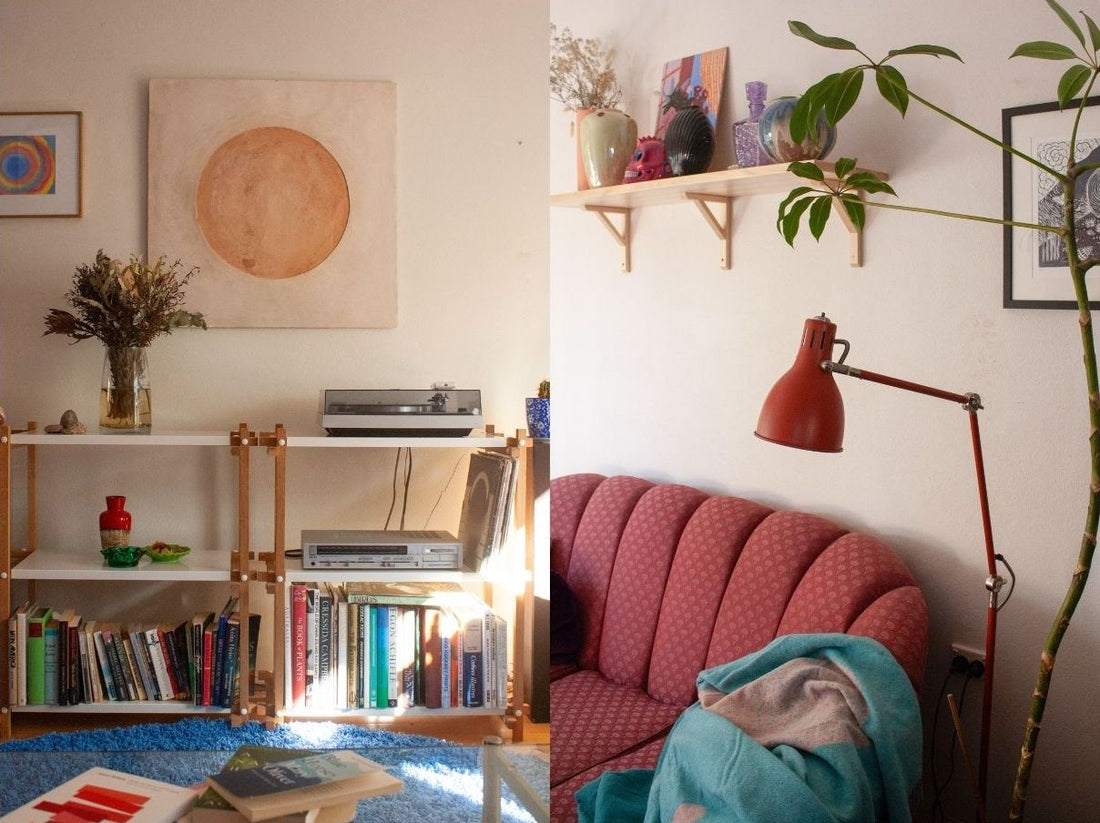Ana Díaz is a dear friend and creative collaborator, having gone to fashion school with Seljak Co-founder Karina around 15 years ago. Through previous work in the fashion industry, Ana guided us in our early days of Seljak Brand, including selecting colours suitable for fibres and the Australian market.
Over the years, Ana has collected the better part of our range. As a textiles and painting artist and designer, who lives and breathes her practice, Ana explores themes of ritual, object and embodiment in her work.
Though her newest additions, the Gather and Passage blankets, Ana reflects on how she builds spaces for creative flow, and all round cosiness coming into a Ngunawal (Canberra) winter!

You have collected so many blankets over the years! How have the energies of your new Gather and Passage blankets landed for you?
I feel very grateful to have both the first ever Seljak and now possibly the last ever Seljak (with many beauties in between). I started my collection in Sydney, but since moving to Canberra they’ve taken on a new importance – they are genuinely essential to my day to day life when the weather starts to get cold.
I’ve been sitting with Gather and Passage for the last few weeks. They arrived during a heat wave, so it was hard to believe I might ever need them… but since then the cold has crept in, and both of them have become my go-to for the cool autumn days.
My favourite thing about Gather and Passage is that they sit somewhere between a shawl and a blanket. I cocoon myself into them with a cup of tea at my computer or on the couch with a book. I answer the door wrapped in them and I wear them to sit in the nature reserve across from my apartment.
I love tapping into the agency of materials and objects in my practice, and I’m always surprised by the discoveries that I make in that process. I’ve spent a lot of time being with both blankets, trying to sense how each of them wanted to be represented, listening to what they want me to know. The names of both blankets spoke a lot to me through this process; Gather, with her earth tones and gentle contrast, spoke to me of stillness, and Passage’s lively palette and otherworldly forms were of transition and movement.

We are deeply familiar with your textiles and painting practices, and know you’ve been exploring movement more recently. How do embodiment and physicality inform your practice?
I’m coming to know that embodiment and physicality aren’t just additions to my practice, rather essential components of it. For most of my life I’ve been more concerned with the end product of my making which has felt like forcing materials, objects, and the artworks themselves into forms that I want them to be, rather than how they might want to express themselves. As I’ve become more curious about the process of making itself, it’s invited more of a dialogue to my practice between me and my materials. I’ve been breaking down my creative practice and playing detective about what works for me, and allowed some breathing room for all of us in the room so we can be more playful and relational.
The importance of my body as one of those materials has been one of my more exciting discoveries. When I honour and listen to my body as a key character in the dialogue of making, I am able to tap into my process in a more meaningful and honest way; how does the stroke of a paintbrush feel against the page? What sounds want to be made in response to that colour? What am I drawn to in this moment?
I reconnected with my textile practice in this way finding that when my body or nervous system is craving slowness, a needle and thread invites (and requires) that pace. In the same vein, if I have a lot of energy in my body, I’m drawn to more instantaneous modalities like dance and sound, often captured in photographs or video. I actually love my phone for this reason, it’s such an amazing tool to capture sound and movement that are of the moment.

Your spaces are warm, whimsical and wondrous. How do you select the objects that inhabit your spaces?
I spend a lot of time at home and it’s important to me that it’s a space that feels safe, inviting and able to hold all of the energies of being human. The way that I’ve been approaching making means that it can be emotionally driven, and I have to make the space feel ‘safe enough’ for me to be able to go there with curiousity. I don’t just make in my studio/workspace; I make in the lounge room, my bedroom, the kitchen. I believe making is the most human thing we do, so every room is tended to in that way.
I’d say that the objects that inhabit my space choose me – everything in my house has a story; where I found it, how it came to me, and who is connected to it. The art on my walls is connected to friends, the furniture are things I’ve found on marketplace or purchased in significant moments of my life, many of my plants have been passed on to my care, I borrowed a rock from a mountain that I’ll return to on my next visit, there’s a candle holder whose pair sits in the home of one of my closest friends in Canberra, and so on.
I love looking around and being reminded of my community, where I’ve come from, and where I hope to go. Context is everything, and as someone with a very associative memory, it’s so inspiring to look around and feel supported by the objects in my home.

Your work and your spaces often feature fresh flowers amongst other natural treasures. In which way does the outdoors inform your creative practice?
I can’t really separate nature from my creative practice, they’re (we’re) inseparable! Flowers are a really literal way for me to express that – it’s impossible not to marvel at the beauty of flowers. When I was painting a lot of still life flowers I was living on a farm in the Canberra area and experiencing the seasonal transition from winter to spring. Blooming flowers felt like such a gift, a gorgeous (and fleeting) moment of time that I wanted to honour and dedicate time and energy towards. I’d say it was a practice of devotion to study them; they were each little deities that taught me so much about patience, attention, gratitude and time.
The natural world is an endless and abundant well of inspiration and it’s where I turn when I’m feeling stuck and hopeless, or joyous and full. It supports me, my body, it generously gives over and over. I often record birds to piece together into soundscapes, crackle leaves and twigs in my hands to feel grounded, or look to the shapes of the trees for inspiration of how to move my body.

What daily rituals keep you comforted during frozen Canberra winters?
When the days get shorter and the weather colder it’s harder to get outside and takes more energy to move my body, so a lot of my rituals are in support of maintaining connection both with my body and with the natural world.
A lot of my winter comforts are about taking care of myself. The long winters here can be really challenging, so a little compassion goes a long way. It really comes back down to basics during this time; good sleep, nourishing food, and moving my body. I naturally don’t have as much energy, so I don’t try to pretend I do. I let myself stay in bed for a little longer, I have regular saunas and hot baths, endless cups of hot tea, and prioritise rugged up forest walks during the day and cosy nights in with friends.
And while the winters can be rough, there’s so much magic there too – I’m so excited for the first frost of the season


